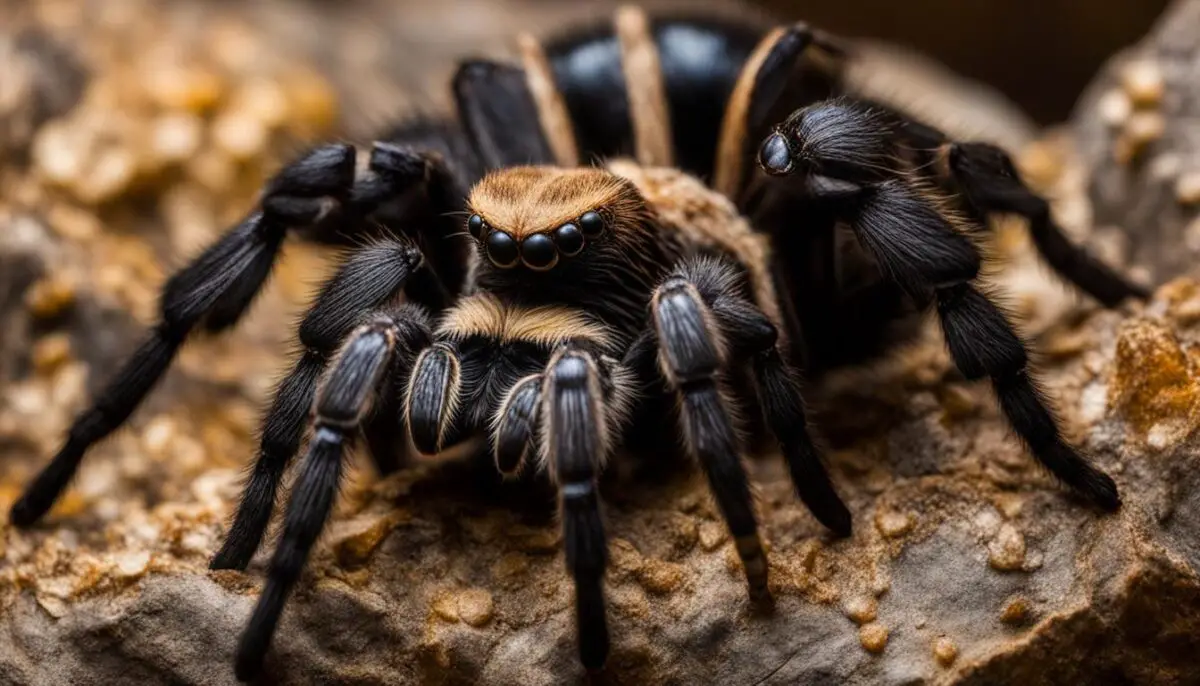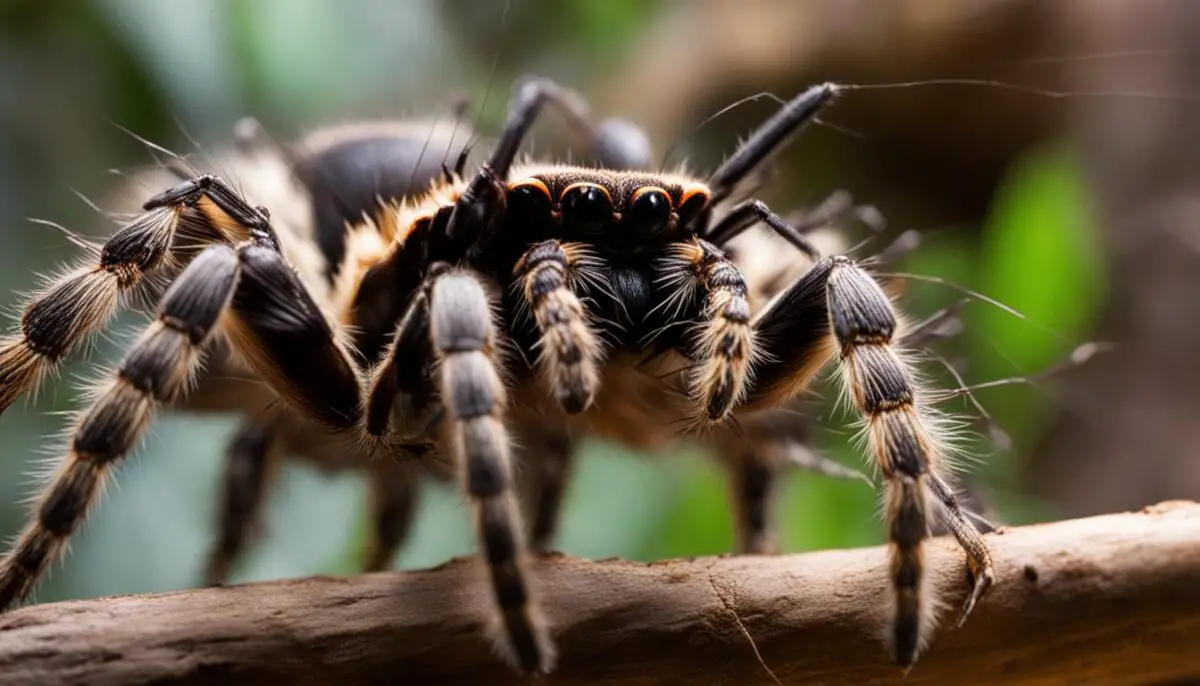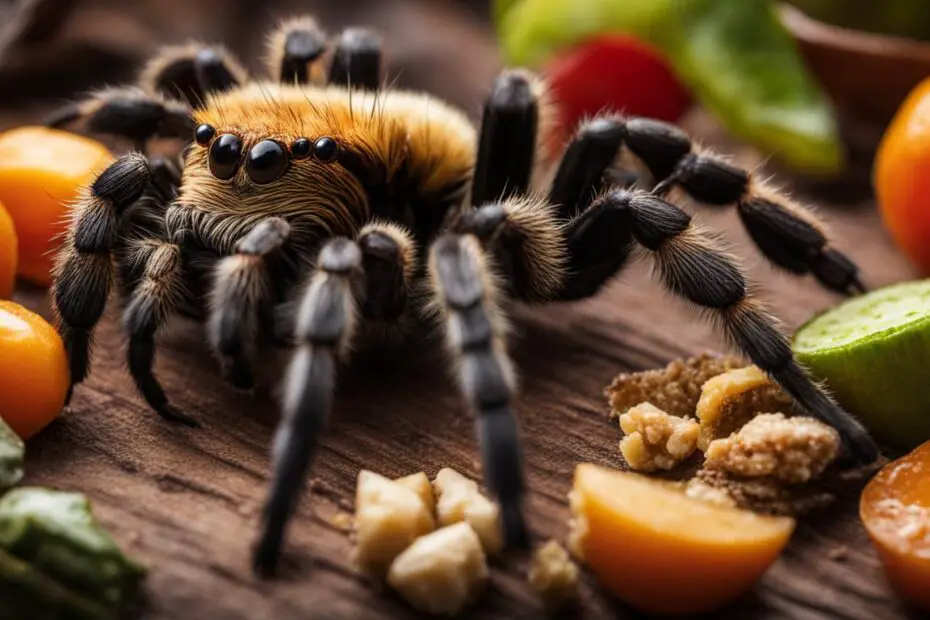Welcome to our comprehensive guide on how often tarantulas feed. If you’re a tarantula owner or considering getting one, understanding their feeding frequency and establishing a feeding schedule is vital for their well-being. Tarantulas have unique dietary needs that depend on various factors such as species, size, age, and seasonal changes. Let’s dive into the fascinating world of tarantula feeding habits and discover how you can provide the best care for your eight-legged companion.
Key Takeaways:
- Tarantula feeding schedules vary based on species, size, age, and seasonal changes.
- Understanding your tarantula’s specific needs and behavior is crucial for establishing an optimal feeding routine.
- Factors like species, size, age, and seasonal changes influence tarantula feeding patterns.
- Choosing the right food and quantity is important to ensure adequate nutrition.
- Observing your tarantula’s feeding patterns and seeking advice from experienced keepers can help in establishing a feeding schedule.
How Often Tarantulas Feed
Factors Affecting Tarantula Feeding Schedule
Tarantulas’ feeding schedules are influenced by various factors, including their species, size, age, and seasonal changes. Each tarantula species has different feeding behavior and appetite, so it’s important to be aware of the normal feeding patterns for your specific spider. By understanding the factors that affect their feeding schedule, you can ensure that your tarantula receives the appropriate amount of food at the right times. tarantula feeding frequency
Species
Different tarantula species have different feeding habits. Some species are more active hunters and require more frequent prey, while others are more sedentary and may eat less frequently. Researching the specific feeding habits of your tarantula’s species will help you determine the optimal feeding schedule. feeding schedule for tarantulas
Size and Age
The size and age of your tarantula also play a role in their feeding frequency. Generally, younger tarantulas (slings) require more frequent meals to support their growth and development. As tarantulas mature and reach adulthood, their feeding frequency may decrease. It’s essential to consider the size and age of your tarantula when establishing their feeding schedule.
Seasonal Changes
Seasonal changes can affect tarantulas’ feeding response. During the winter months, tarantulas may slow down their feeding as their metabolism decreases. It’s important to take seasonal changes into account when planning your tarantula’s feeding routine. tarantula diet
Conclusion
Understanding the factors that affect tarantula feeding schedules is crucial for providing optimal care for your pet. By considering the species, size, age, and seasonal changes, you can establish a feeding routine that meets your tarantula’s nutritional needs and promotes their overall health and well-being. how frequently do tarantulas eat
Choosing the Right Food and Quantity
When it comes to feeding your tarantula, it’s important to consider both the type of food and the quantity you provide. Different prey insects offer varying levels of nutrition, so offering a balanced diet is key. Bugs like cockroaches and crickets are rich in protein, while worms are higher in fat. By providing a variety of prey, you can ensure your tarantula receives the necessary nutrients. tarantula meal frequency
The quantity of food you offer will depend on the size of your tarantula. Slings, or young tarantulas, generally eat more frequently and require smaller prey. As they grow into adults, their feeding frequency decreases and they can consume larger prey. It’s important to remember that the prey should always be smaller than the tarantula’s thorax to prevent choking or injury.
To help you visualize the appropriate food size for your tarantula’s size, refer to the table below:
| Tarantula Size | Prey Size |
|---|---|
| Slings (0.5-2 inches) | Fruit flies, pinhead crickets |
| Juveniles (2-4 inches) | Small crickets |
| Subadults (4-6 inches) | Medium crickets |
| Adults (6+ inches) | Large crickets, roaches |
Remember to observe your tarantula’s feeding patterns and adjust the quantity accordingly. If your tarantula consistently refuses food, they may not be hungry or could be preparing to molt. It’s essential to pay attention to your tarantula’s individual needs and behavior to ensure they are getting the right amount of food. feeding tarantulas regularly
Observing Your Tarantula’s Feeding Patterns
Observing your tarantula’s feeding patterns is essential in creating a feeding schedule that meets their specific needs. By closely monitoring their behavior, you can determine the ideal frequency and quantity of food to ensure their health and well-being. Here are some tips on how to observe and establish a tarantula feeding routine:
Paying Attention to Behavior
Take note of your tarantula’s feeding response. Do they eagerly pounce on their prey, or do they show little interest? Some tarantulas may refuse food for extended periods, which can be normal behavior for their species. However, consistent refusal may indicate a problem or stress. By observing their behavior, you can gauge if they require a change in feeding frequency or prefer certain types of prey. tarantula food intake pattern
Experimenting with Feeding Frequencies
Every tarantula is unique, so it’s essential to experiment with different feeding frequencies to find the right balance. Start by offering food once a week and observe their response. If they consistently refuse food or show signs of hunger, you may need to increase the frequency. Conversely, if they consistently reject prey or appear disinterested, you may need to reduce the frequency. It’s important to find a routine that suits your tarantula’s appetite and keeps them healthy.
Seeking Advice from Experienced Keepers
Joining online forums and seeking advice from experienced tarantula keepers can provide valuable insights into feeding routines. By connecting with other enthusiasts who have tarantulas of similar age and size, you can learn from their experiences and gain a better understanding of what works best for your tarantula’s species. However, it’s essential to remember that every tarantula is unique, so it’s crucial to combine advice with your own observations and judgment.
By observing your tarantula’s feeding patterns, experimenting with feeding frequencies, and seeking advice from experienced keepers, you can create a tarantula feeding schedule that promotes their health and well-being. feeding routines for tarantulas

Overfeeding and Precautions
Many tarantula owners worry about overfeeding their spiders. While it’s important not to have obese tarantulas, it’s quite difficult to overfeed them. Most tarantulas will stop eating once they’re full, preventing overfeeding. However, it’s important to monitor the size of your tarantula’s abdomen and cut back on feeding if they start to look unusually plump.
Providing a balanced diet and feeding appropriate-sized prey will help maintain your tarantula’s health. Tarantulas primarily feed on small insects like crickets, millipedes, and grasshoppers in the wild. In captivity, their diet mainly consists of insects such as crickets, roaches, and worms. It’s important to offer a variety of gut-loaded bugs to ensure adequate nutrition.
To prevent overfeeding, avoid feeding your tarantula prey that is larger than their thorax. This helps prevent potential complications such as difficulty in digestion or injury. Additionally, avoid feeding your tarantula too frequently. The feeding frequency will depend on the species, age, and size of your tarantula. Monitoring your tarantula’s feeding habits and adjusting the frequency accordingly is key to preventing overfeeding.
| Signs of Overfeeding | Precautions |
|---|---|
|
|
Keeping Records and Documentation
Organizing your tarantula’s feeding schedule is essential for providing consistent care and tracking their growth and health. Many tarantula owners, especially those with larger collections, keep detailed records of feeding dates and quantities. This helps create a routine and ensures that each tarantula gets the appropriate amount of food.
By maintaining a feeding log, you can easily track when and how much you feed each tarantula. This record-keeping allows you to observe patterns and make adjustments as needed. For example, if a particular tarantula consistently refuses food, you can review the log to identify any changes in behavior or determine if further investigation is necessary.
Joining online forums and communities dedicated to tarantula keeping can also provide valuable insights into feeding schedules for tarantulas of similar age and size. Experienced keepers often share their own records and feeding routines, allowing you to compare and refine your own approach. These communities can also serve as a resource for troubleshooting feeding issues or seeking advice from fellow enthusiasts.
| Date | Tarantula | Feeding Quantity |
|---|---|---|
| May 1, 2022 | Brachypelma smithi | 2 crickets |
| May 3, 2022 | Grammostola rosea | 1 roach |
| May 6, 2022 | Aphonopelma chalcodes | 3 mealworms |
Keeping accurate records not only helps with maintaining a consistent feeding schedule but also provides valuable information for future reference. As your tarantulas grow and molt, you can track their progress and adjust feeding quantities accordingly. Overall, organizing your tarantula’s feeding schedule through documentation ensures their well-being and allows for better care and observation.
What Do Tarantulas Eat?
Tarantulas, both in the wild and captivity, have a diverse diet that mainly consists of small insects. In their natural habitat, tarantulas feed on creatures like crickets, millipedes, and grasshoppers. These insects provide the necessary nutrients for the tarantula’s survival and growth. When kept as pets, it’s important to replicate their natural diet to ensure their optimal health.

For captive tarantulas, the most common food options are live insects that can be purchased from pet stores or bred at home. Gut-loaded bugs such as crickets and roaches are excellent choices as they are rich in protein. Worms are another option, and they provide a fatty food source for tarantulas. Fruit flies and larvae can also be included in their diet.
Table: Common Tarantula Food
| Food Type | Nutritional Value |
|---|---|
| Crickets | High protein content |
| Roaches | Protein-rich and nutritious |
| Worms | High fat content |
| Fruit flies | Small, easily digestible |
| Larvae | Good source of protein |
It’s important to note that the size of the prey should be appropriate for the tarantula’s size. Prey items should be smaller than the tarantula’s thorax to avoid any potential choking hazards. Providing live food is crucial as it stimulates the tarantula’s natural predatory instincts and keeps them active and healthy.
Feeding Tarantulas: A Step-by-Step Guide
Feeding your tarantula is an essential part of their care routine. By following a few simple steps, you can ensure that your tarantula receives the proper nutrition and stays healthy. Here is a step-by-step guide on how to feed a tarantula:
- Obtain live food: Tarantulas are carnivorous and require live insects as their primary food source. Crickets, roaches, and mealworms are popular choices. It’s important to provide your tarantula with food that is smaller than its body size.
- Create a suitable feeding environment: Place the live food into the tarantula’s terrarium. Ensure that the prey is moving around, as this will stimulate the tarantula’s hunting behavior.
- Offer the food while the tarantula is in its hiding spot: Tarantulas are nocturnal creatures and tend to be more active during the night. Place the food near the tarantula’s hiding spot to encourage feeding.
- Remove uneaten prey: After a few hours, check if the tarantula has finished eating. If there is uneaten prey remaining, it should be removed from the terrarium to prevent mold and fungus growth.
It’s essential to adjust the feeding frequency based on your tarantula’s species, age, and appetite. Some tarantulas prefer to be fed more frequently, while others may eat less often. By observing your tarantula’s behavior and appetite, you can determine the ideal feeding schedule for them.
Remember, providing a balanced diet and monitoring your tarantula’s feeding patterns are crucial for their overall health and well-being.

Tarantula Feeding Tips
“Feeding your tarantula can be an exciting and rewarding experience. Here are a few additional tips to enhance your feeding routine:
– Rotate the types of live food you offer to provide variety and ensure a well-rounded diet.
– Avoid feeding your tarantula wild-caught insects, as they may carry diseases or parasites that can harm your spider.
– If you have multiple tarantulas, ensure each one receives its own feeding portion to prevent competition and potential aggression.
– Do not handle your tarantula while it is feeding, as this can cause stress and potentially lead to aggression.”
Feeding Schedule for Tarantulas
Establishing a feeding schedule for your tarantula can vary depending on the species and individual factors. However, as a general guideline, slings (young tarantulas) typically eat more frequently than adults. Here is an example of a basic tarantula feeding schedule:
| Tarantula Age | Feeding Frequency |
|---|---|
| 0-3 months | Every 2-3 days |
| 3-12 months | Every 4-7 days |
| 12+ months | Every 7-10 days |
It’s important to note that these are general guidelines and may need to be adjusted based on your specific tarantula’s appetite and behavior. Regular monitoring and observation are key to determining the best feeding schedule for your tarantula.
Conclusion
Feeding tarantulas can be a fascinating and rewarding experience. By understanding the needs and behavior of your tarantula, you can establish a feeding schedule that promotes their optimal health and growth. Remember to consider factors such as species, size, age, and seasonal changes when determining the frequency of feeding.
Choosing the right food and quantity is also crucial for your tarantula’s nutrition. Providing a balanced diet that includes a variety of prey insects will ensure they receive the necessary nutrients. Adjusting the quantity of food based on the size of your tarantula is important – slings may require more frequent feeding compared to adult tarantulas.
Observing your tarantula’s feeding patterns and seeking advice from experienced keepers can provide valuable insights. Every tarantula is unique, so it’s essential to pay close attention to their behavior and adjust the feeding routine accordingly. While overfeeding can be a concern, most tarantulas will regulate their intake and stop eating once they’re full.
Keeping records of your tarantula’s feeding schedule and growth can help you monitor their health and provide consistent care. Online forums and communities are also great resources for learning about feeding schedules for tarantulas of similar age and size. By following these guidelines and tailoring them to your tarantula’s specific needs, you can ensure a happy and healthy tarantula.
FAQ
How often should I feed my tarantula?
Tarantula feeding schedules can vary based on species, size, age, and seasonal changes. Understanding the specific needs and behavior of your tarantula will help you establish a feeding routine that promotes optimal health and growth.
What factors affect a tarantula’s feeding schedule?
Tarantulas’ feeding schedules are influenced by factors such as species, size, age, and seasonal changes. Each tarantula species has different feeding behavior and appetite, so it’s important to be aware of the normal feeding patterns for your specific spider.
How do I choose the right food and quantity for my tarantula?
The type of food you provide for your tarantulas plays a role in their appetite. Different prey insects offer different nutrition levels. It’s important to offer a balanced diet to ensure adequate nutrition. The quantity of food will depend on the size of your tarantula.
How can I observe my tarantula’s feeding patterns?
Every tarantula is unique, so observing their feeding patterns is crucial in establishing a feeding schedule. Paying close attention to your tarantula’s behavior and experimenting with different feeding frequencies will help you determine the best routine for them.
Is there a risk of overfeeding tarantulas?
Many tarantula owners worry about overfeeding their spiders. While it’s important not to have obese tarantulas, it’s quite difficult to overfeed them. Most tarantulas will stop eating once they’re full, preventing overfeeding. However, it’s important to monitor the size of your tarantula’s abdomen and cut back on feeding if they start to look unusually plump.
Should I keep records of my tarantula’s feeding schedule?
Many tarantula owners, especially those with larger collections, keep records of their tarantula’s feeding schedule and molt dates. This helps organize their feeding routine and ensure they are providing consistent care.
What do tarantulas eat in the wild and in captivity?
In the wild, tarantulas primarily feed on small insects like crickets, millipedes, and grasshoppers. In captivity, their diet is mainly based on insects. Gut-loaded bugs such as crickets, roaches, and worms are excellent food choices for tarantulas.
How do I feed my tarantula?
Feeding your tarantula involves purchasing live food, determining the appropriate amount based on size and age, and providing the food in the terrarium while the tarantula is in its hiding spot. Live food should be alive and capable of moving around to stimulate the tarantula’s hunting behavior.
What should I consider when feeding tarantulas?
Feeding tarantulas requires understanding their species, size, age, and behavioral patterns. Establishing a feeding schedule based on these factors, providing a varied and balanced diet, and observing your tarantula’s behavior will promote their health and growth.


I’m not that much of a online reader to be honest but your sites really nice, keep it up! I’ll go ahead and bookmark your site to come back later on. All the best
Audio started playing as soon as I opened this webpage, so frustrating!
Appreciating the persistence you put into your website and detailed information you present. It’s good to come across a blog every once in a while that isn’t the same out of date rehashed material. Fantastic read! I’ve bookmarked your site and I’m adding your RSS feeds to my Google account.
Hey there! I know this is kinda off topic nevertheless I’d figured I’d ask. Would you be interested in trading links or maybe guest writing a blog post or vice-versa? My blog discusses a lot of the same topics as yours and I think we could greatly benefit from each other. If you might be interested feel free to send me an email. I look forward to hearing from you! Great blog by the way!
Have you ever thought about publishing an e-book or guest authoring on other sites? I have a blog centered on the same subjects you discuss and would love to have you share some stories/information. I know my viewers would value your work. If you are even remotely interested, feel free to shoot me an e mail.
I truly enjoy looking through on this website , it has got good posts.